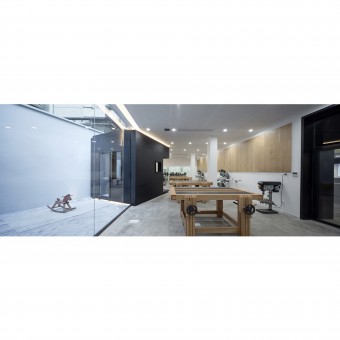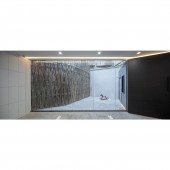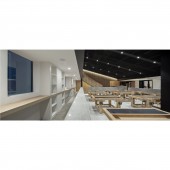M.Y.Lab Wood Workshop by Fan Jiujiang |
Home > Winners > #62282 |
 |
|
||||
| DESIGN DETAILS | |||||
| DESIGN NAME: M.Y.Lab PRIMARY FUNCTION: Wood Workshop INSPIRATION: As the nostalgia atmosphere deepens, wood crafting centre, the future role that this space will play, is tasked with a similar subject. Wood crafting, as a conventional technique that left behind by our modernised urban lifestyle, is in need to be rediscovered as a piece of treasure lost in time. UNIQUE PROPERTIES / PROJECT DESCRIPTION: The M.Y.Lab Wood Workshop is located on the first floor of a warehouse, which used to be the Dongfeng Sofa Factory in Changning District, Shanghai. Adjacent to the warehouse, it is stood a new-built 150㎡ attached room, forming a triangle lacunain-between. The task is to refurbish the 300㎡ one-storey warehouse into a two-storey commercial space, which is to be operated as a wood crafting learning centre. OPERATION / FLOW / INTERACTION: This design proposed an implantation of an 'archaeological excavation site' recreation into the original space with the height of 5 metres. The main wood crafting room is forged into a secluded space, by being positioned on the sunken floor behind the entrance wall. Above this space lays a massive pent roof, formed by a black metal mesh. From the top of the ramp, sunlight spills into the room, endowing it with the beauty of ritual. PROJECT DURATION AND LOCATION: The project was designed between October 2016 to December 2016. And the construction is completed in June 2017 in 1205 Kaixuan Road, Changning District, Shanghai, China. FITS BEST INTO CATEGORY: Interior Space and Exhibition Design |
PRODUCTION / REALIZATION TECHNOLOGY: After the formation of the main space, next is to design its interfaces separating it from other spaces. Three of the most common materials, metal sheets coated with black fluorocarbon, oak panels and white paint, are put in use. Along with the terrazzo floorings and walls in the main space, as well as the black metal ceiling above, a harmonious theme of materials and colours is constituted. SPECIFICATIONS / TECHNICAL PROPERTIES: A narrow and lofty corridor is set as the entrance to the main space. On the wooden wall, a series of display cabinets and LED screens are installed continuously. Meanwhile, a space under the screen closest to the entrance is designed for exhibiting furniture works. TAGS: Workshop, Box, Renovation, Interior Design, Floating Structures RESEARCH ABSTRACT: What left the most impression in the site on the first visit was, instead of the space itself, the overground separated from the old warehouse by just the warehouse's enclosure. Trains pass through the overground rail every other minute or so, leavingloud rumblings behind echoing in the place, as a reminder of the long way of globalisation and modernisation this city has come. CHALLENGE: Two black metal boxes are introduced into the route. One, with a staircase inside, is located between the two storeys as a transportation junction, whose tilted top parallels the form of the ceiling in the main space. The other box, functioning as the tearoom, is located between the attached room and its yard as a pathway. Half of the box interlocks with the interior, bringing into the space formative diversity. ADDED DATE: 2017-11-17 02:57:39 TEAM MEMBERS (9) : Lead Architects: Fan Jiu-Jiang, Lead Architects: Zhai Wen-Ting, Lead Architects: Chen Kai-Xiong, Lead Architects: Li Ting, Lead Architects: Sun Fu-Dong, Lead Architects: Chen Liu-Fen, Lead Architects: Lyu Shuang-Er, Lead Architects: Zhu Wei-Nan (Intern) and Consultants: Neng Xiao-Wen IMAGE CREDITS: Image #1: Photographer SHIROMIO Studio, Shanghai, 2017 Image #2: Photographer SHIROMIO Studio, Shanghai, 2017 Image #3: Photographer SHIROMIO Studio, Shanghai, 2017 Image #4: Photographer SHIROMIO Studio, Shanghai, 2017 Image #5: Photographer SHIROMIO Studio, Shanghai, 2017 |
||||
| Visit the following page to learn more: http://kks.me/au2AH | |||||
| AWARD DETAILS | |
 |
M.y.lab Wood Workshop by Fan Jiujiang is Winner in Interior Space and Exhibition Design Category, 2017 - 2018.· Press Members: Login or Register to request an exclusive interview with Fan Jiujiang . · Click here to register inorder to view the profile and other works by Fan Jiujiang . |
| SOCIAL |
| + Add to Likes / Favorites | Send to My Email | Comment | Testimonials | View Press-Release | Press Kit |







